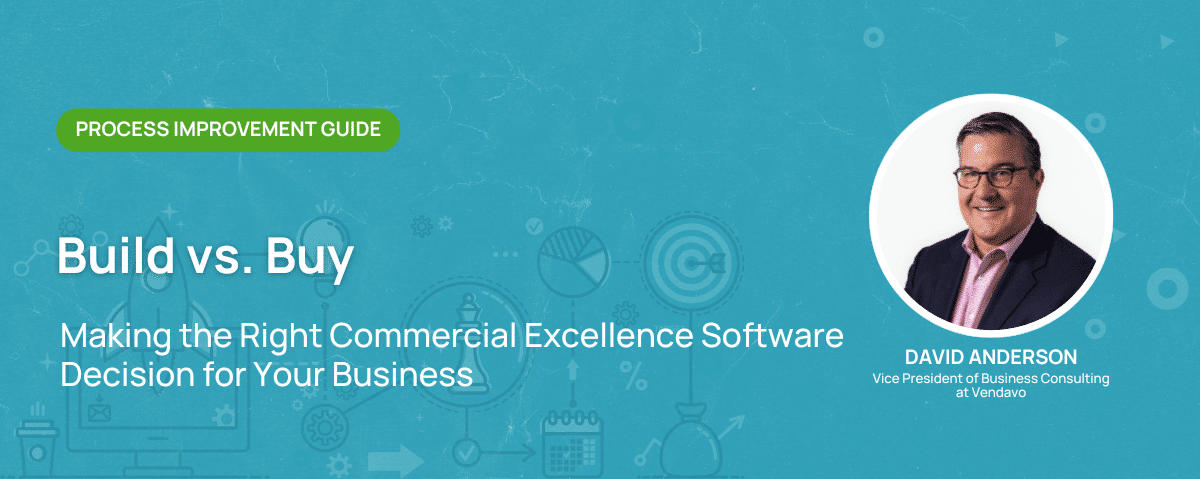
Organizations that want to grow profitably have a tough choice: build an in-house commercial excellence solution, or buy software from a third-party vendor. A lot goes into this decision, and you don’t have to make it alone. David Anderson, Vice President of Business Consulting at Vendavo, explains how key factors like cost, risk, scalability, and long-term value each impact building or buying to help you make the right decision for your operations.
If your organization wants to grow profitably, your team is going to face some pivotal, future-altering business decisions. One key decision is whether to build your commercial software solution in-house or buy that solution from a third-party vendor.
No two operations are the same. Whether you choose the build route or the buy route, you should be mindful about what’s in store.
I’ve spent many years working alongside businesses who have to make these important decisions. I’ve also been on both sides of the equation as a customer and a vendor. Given my experience, I wanted to share my unique perspective on how to think about these decisions. Plus, let you know about a few things that I often see businesses overlook.
Factors to Consider in Building vs. Buying
The first thing to note in these situations is that everyone thinks they are special. It can be tempting to believe that your business is so unique it requires a custom-tailored solution to address its issues. That’s where these questions can be helpful:
- Uniqueness – Really interrogate this question. How unique are your business processes? Is it possible that you have similar processes to other companies like yours?
- Funding & Resource Environment – Do you have the resources available to take on building a solution? What resources are required? Do you have competing priorities?
- Time Constraints – When do you need a solution in place?
- Culture – What is the political environment in IT for commercial vs in-house work?
After you answer these questions, you need to outline the key factors influencing the build vs. buy decision. These include:
- Current process state
An in-house solution can be tailored to fit these precisely, whereas commercial software might require some adjustments.
- Internal capabilities
Does your team have the bandwidth and expertise to build and maintain a solution, or would they be better utilized in other strategic areas?
- Budget constraints
This includes initial costs as well as long-term expenses in areas such as maintenance, updates, and support.
- Scalability needs
Consider future growth. How well would each option scale with your business? Commercial software often offers more flexibility in this regard.
- Risk tolerance
Assess the risks associated with each approach, including project delays, cost overruns, and implementation challenges.
Understanding these nuances will help you weigh the benefits of a tailored, internally managed system against the potential hurdles.
What to Know About In-House Builds
Building an in-house solution offers customization and control that can be tailored to current workflows and stakeholder needs. This ensures the solution fits like a glove, addressing every specific requirement of your business.
But this route also comes with challenges. Internal teams understand your processes, but may lack the broader experience to implement best practices and innovative solutions.
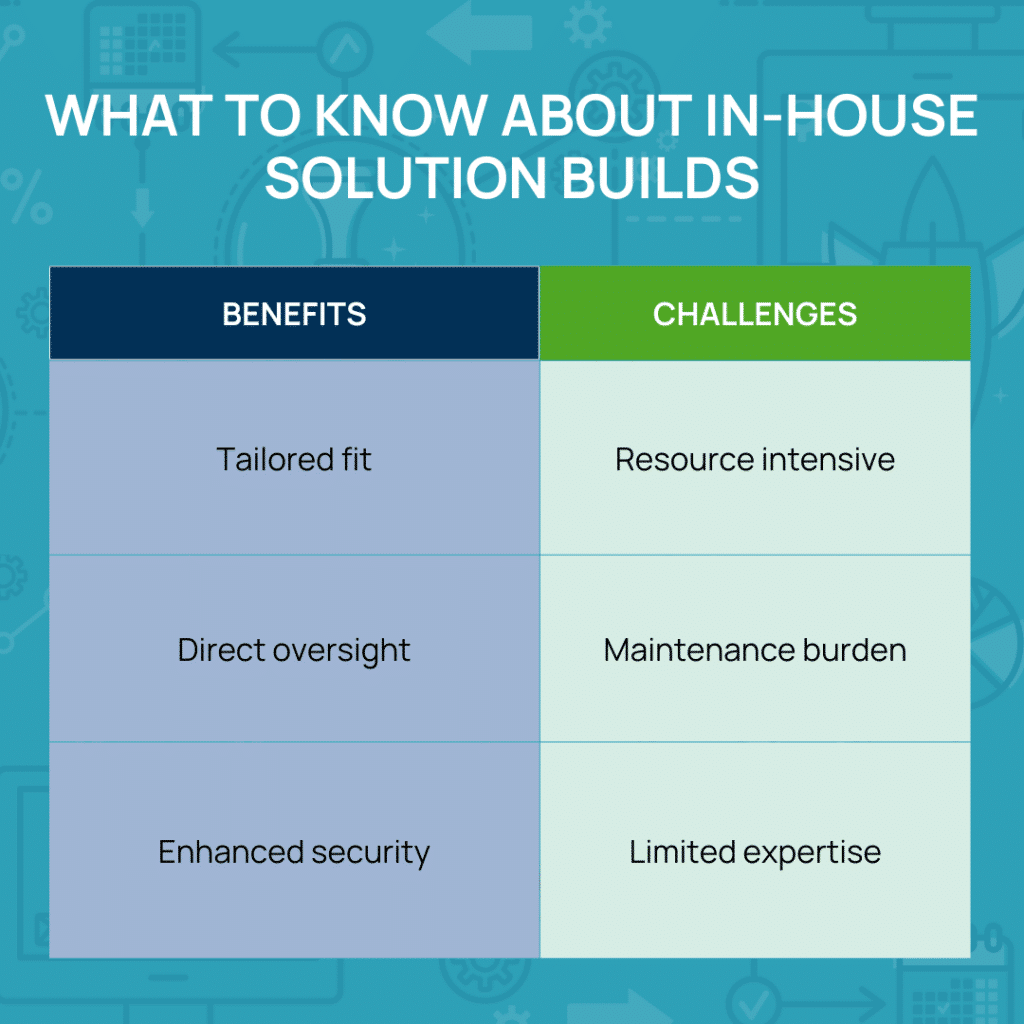
Benefits of In-House Solutions
- Tailored fit – an in-house solution can be designed to meet the exact needs of your business, incorporating specific functionalities and workflows
- Direct oversight – control over the development process means you can adjust quickly and ensure the solution aligns with your company’s strategic goals
- Enhanced security – you have complete control over the security measures and protocols, reducing the risk of external breaches
Challenges of In-House Solutions
- Resource intensive – building in-house requires significant time, effort, and resources, which can stretch your team and divert focus from other critical projects
- Maintenance burden – your internal team is responsible for ongoing maintenance, updates, and troubleshooting, which can be costly and time-consuming
- Limited expertise – does your team have exposure to the industry trends and best practices to create a solution as robust and innovative as commercial offerings?
The Commercial Software Edge: Expertise and Scalability
Commercial software vendors bring extensive experience from working with businesses like yours. They build this expertise into their products, offering best practices and insights from previous implementations as well as robust infrastructure for user administration, roles, permissions, and integrations. Value is in their DNA.
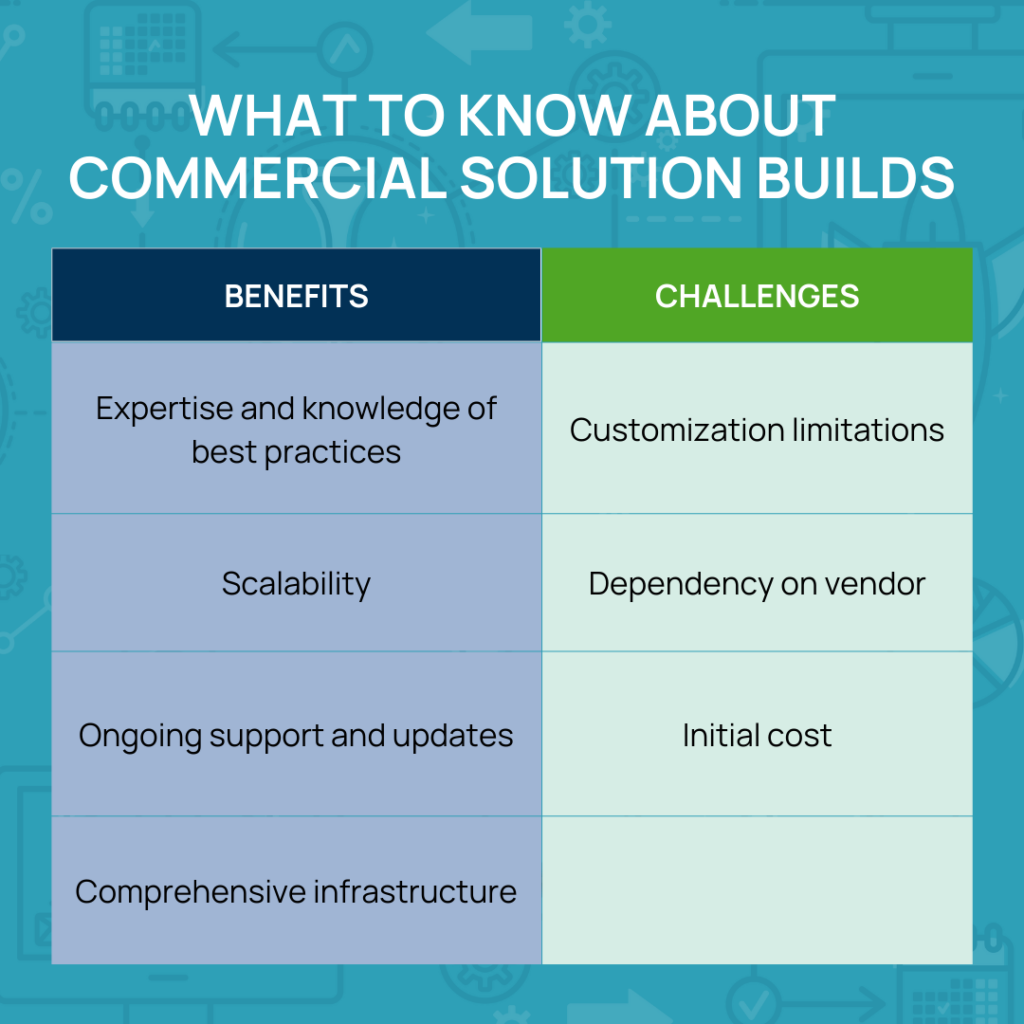
Benefits of Commercial Software
- Expertise and best practices – you benefit from the collective knowledge of many businesses and experts
- Scalability – designed to scale easily with your business, accommodating growth and increasing data processing needs without significant overhauls
- Ongoing support and updates – receive regular updates, enhancements, and support so the software remains current and functional
- Comprehensive infrastructure – user administration, roles, permissions, and integrations are built-in, reducing the need for additional development
Challenges of Commercial Software
- Customization limitations – highly customizable but might not meet every specific business need without additional configuration or customization
- Dependency on vendor – you’re dependent on the third-party vendor’s timelines for updates, support, and issue resolution
- Initial cost – upfront costs can be higher compared to starting an in-house project (although the long-term savings often outweigh this)
The Cost Conversation
Let’s talk about costs.
A common misconception is that building in-house is cheaper. It might seem more cost-effective up front, but companies often underestimate the long-term investments they’ll have to make in maintenance and support. Commercial software, with its regular updates and enhancements, ensures long-term sustainability and cost-effectiveness.
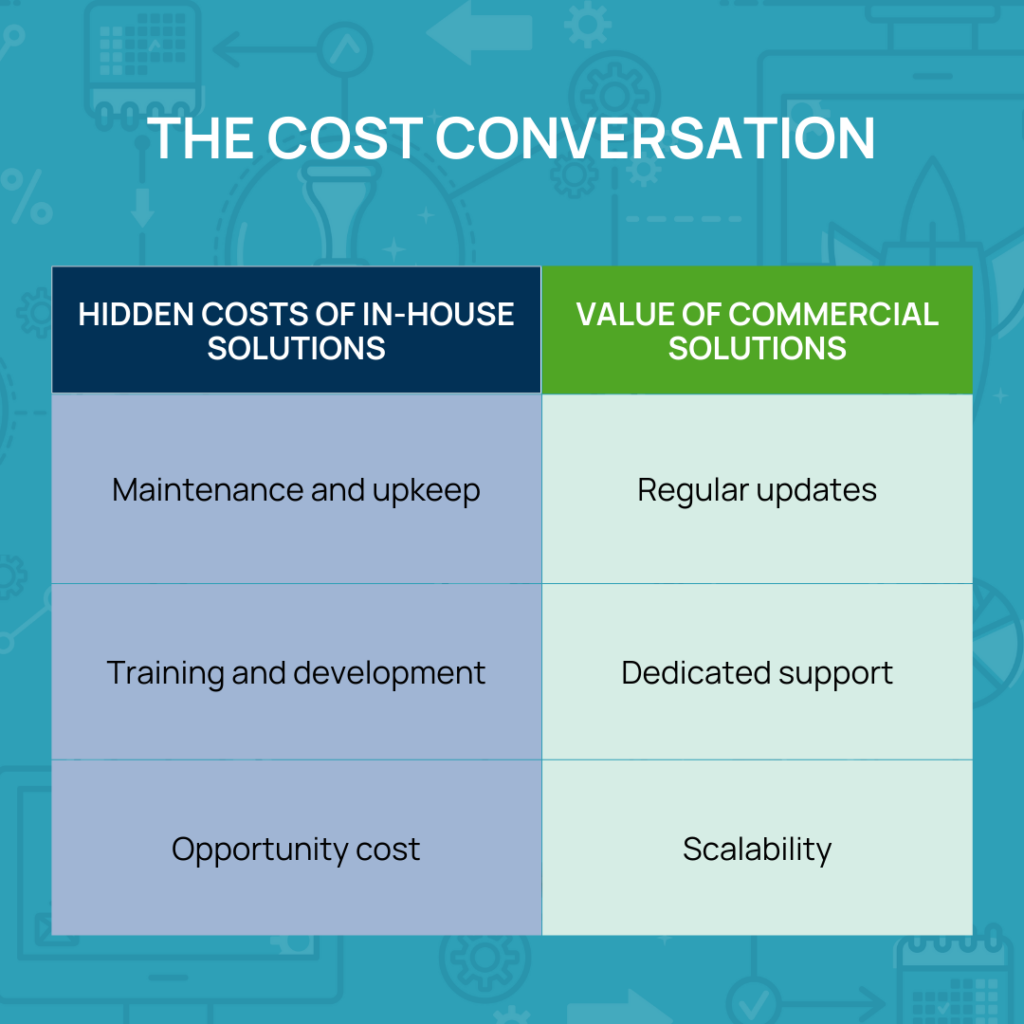
Hidden Costs of In-House Solutions
- Maintenance and upkeep – keeping an in-house solution running smoothly requires continuous attention and resources, which can add up over time
- Training and development – ensuring your team is skilled in using and maintaining the solution requires ongoing training and development, which can be costly
- Opportunity cost – diverting your team’s focus to building and maintaining an in-house solution can lead to missed opportunities in other strategic areas
Value of Commercial Solutions
- Regular updates – vendors continuously improve their products, adding features and functionalities that keep your solution up to date with industry standards
- Dedicated support – access to dedicated support teams means issues can be resolved quickly and efficiently, minimizing downtime
- Scalability – commercial software can easily scale with your business, supporting growth and adapting to changing needs without significant additional investment
How to Navigate Risk Management and Uncertainty
Risk is part of any major business decision, and the build vs. buy choice is no different. In-house projects often carry higher delivery risks due to a lack of experience with complex implementations. Commercial vendors have honed their processes through numerous deployments, and can offer reduced risk and smoother transitions.
In-House Project Risks
- Scope creep – you need clear boundaries and experienced project management to avoid expanding beyond the original scope, leading to delays and increased costs
- Technical challenges – building a solution from scratch can present unforeseen technical challenges that require significant time and resources to resolve
- Resource strain – managing an in-house project alongside other responsibilities can strain your team and lead to burnout or decreased productivity
Mitigating Risks with Commercial Software
- Proven processes – vendors have established processes for implementation, reducing the likelihood of delays and ensuring a smoother transition
- Extensive support – access to vendor support teams means that issues can be quickly addressed, minimizing disruption to your business
- Risk mitigation – vendors are experienced in identifying and mitigating risks, ensuring your project stays on track and within budget
Strategic Considerations: Thinking Beyond the Immediate Implications
When deciding between building and buying, consider the long-term strategic implications, such as scalability, future enhancements, and potential value creation.
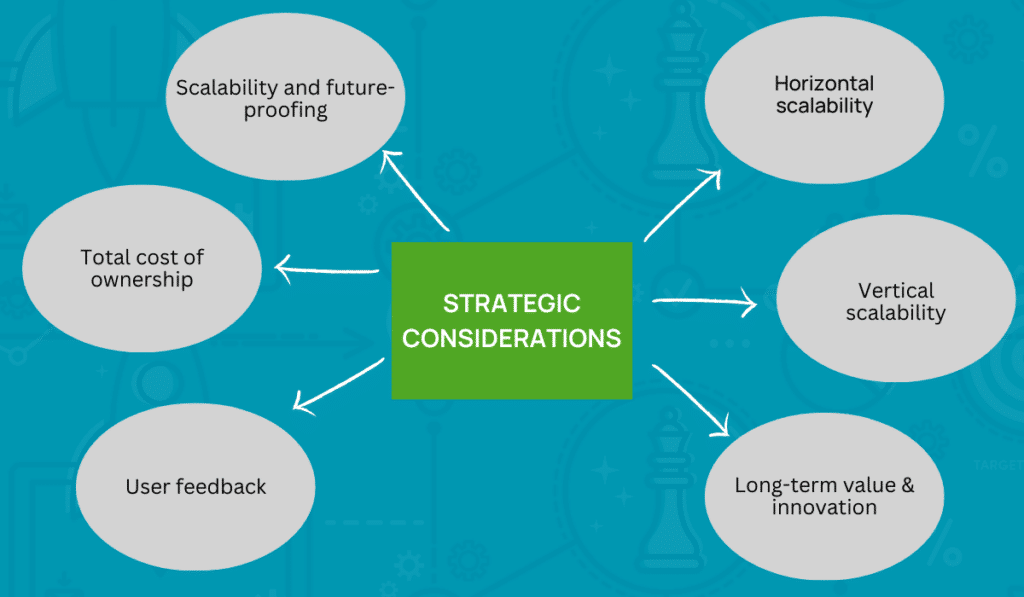
- Scalability and future-proofing
Commercial solutions are designed to scale. This ensures the solution evolves with your business, supporting future growth and innovation.
- Horizontal scalability
Adding more users or expanding functionality is straightforward with commercial software, ensuring that the solution grows with your business.
- Vertical scalability
As your data processing needs increase, commercial software can handle larger volumes without significant performance issues.
- Long-term value and innovation
Vendors regularly update their products using the latest tech advancements. This keeps their solutions cutting-edge.
- User feedback
Commercial software often incorporates feedback from a wide range of users, leading to a more refined and effective solution.
- Total cost of ownership
Evaluate the total cost of ownership over the solution’s lifecycle, including initial development or purchase costs, ongoing maintenance, and potential upgrades.
Best Practices for Build vs. Buy Decision-Making
Making the right decision for your operations involves evaluating all factors, including costs, risks, and strategic implications. Here are some best practices:
- Conduct a comprehensive cost analysis
Look beyond initial budgets and consider long-term costs like maintenance, support, and scalability. This ensures that you understand the true financial impact of your decision.
- Assess organizational capabilities
Evaluate the strengths, skills, and limitations of your internal IT team and their ability to handle complex projects. This helps determine whether your team can successfully build and maintain an in-house solution.
- Consider future needs
Think about how the solution will scale and adapt to future business requirements and market changes. Consider your company’s growth projections. This ensures that your investment remains valuable over time.
- Leverage external expertise
Value the experience and best practices that commercial vendors bring to the table. Their expertise can enhance the quality and effectiveness of the solution. You want their expert insights into best practices and potential pitfalls.
- Focus on value creation
Look for solutions that offer long-term value and ongoing innovation. Define metrics to measure the value delivered by the solution and ensure it aligns with your goals. This ensures that your investment delivers continuous benefits to your business.
Expertise Matters
The build vs. buy decision is complex, and choosing the right option for your individual business, business unit, geography, and IT environment is important. But thorough evaluation and a focus on long-term value can help you make an informed choice that aligns with your strategic goals.
Expertise is crucial for successful technology implementation. While in-house teams provide valuable insights into specific processes, they may lack the broader perspective and experience that commercial vendors offer.
Partnering with seasoned experts can significantly reduce risk, ensure smoother implementation, and drive greater business value.
Ready to take your organization’s growth and profitability to the next level? Reach out today to speak with a Vendavo expert about how our full suite of commercial excellence and revenue optimization solutions can help.
